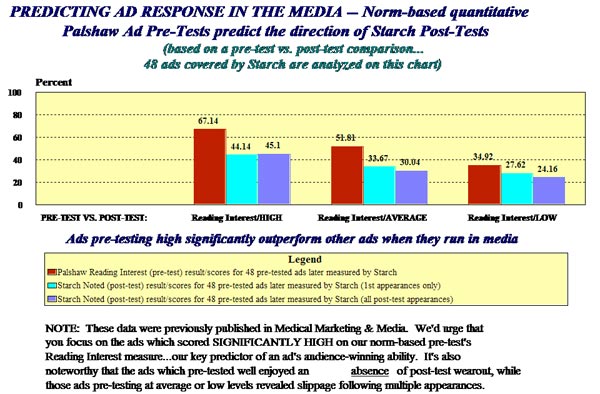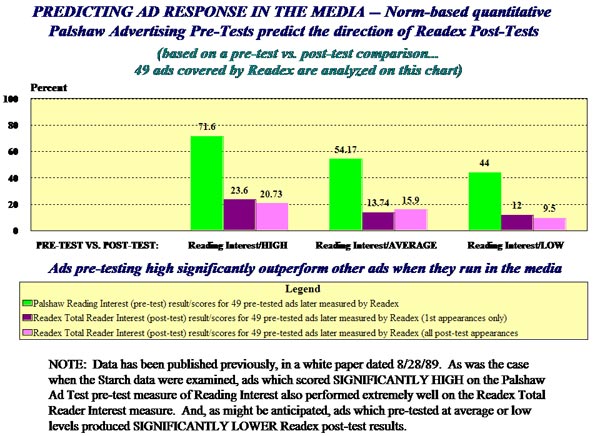|
(based on multiple comparisons of Palshaw Ad Test pre-test results with such standardized post-test advertising readership services as Starch and Readex)
THE QUESTION: If you pre-test your advertising using the Palshaw Ad Test method, will your survey findings predict the direction of ad response (memorability/recall) in the media?
THE ANSWER: The pages which follow reveal the consistency of the Palshaw Ad Test in predicting after-the-fact response to the same advertising once it appeared in publications where ad readership is regularly reported by a major service such as Starch or Readex.
INTRODUCTION
The charts which follow will illustrate the relationship between Palshaw Ad Test pre-test scores (which scored high, average or low versus our pre-test norms) and scores for the same ads provided by publisher-supported, in-publication ad readership services such as Starch and Readex.
Findings revealed in the accompanying charts will document these points:
- Palshaw Ad Tests will predict how your advertising can be expected to perform in the media.
- The likelihood of a high-scoring pre-test ad doing badly in the media is very slim (unless the media audience is completely different from the pre-test sample), and
- The likelihood of a low-scoring pre-test ad doing well in the media is equally slim.
Comparison “A” – The relationship between our pre-test measure of Reading Interest and Starch Noted scores (a standardized in-publication post-test ad readership service)
First, let’s examine the relationship between our initial measure of Reading Interest (our key measure of an ad’s ability to generate an audience) and Starch Noted scores, the key audience size measure provided by that post-test ad readership service.
You will see that ads scoring significantly high on our Reading Interest measure will consistently score significantly higher on the Starch Noted post-test than will ads which performed at only average or significantly low levels on our pre-test.

Comparison “B” – The relationship between our pre-test measure of Reading Interest and Readex Total Reader Interest scores (a standardized in-publication post-test ad readership service)
Next, let’s examine the relationship between that same initial measure of Reading Interest and Readex Total Reader Interest scores, the key audience size measure provided by that post-test ad readership service.
You will again see that ads scoring significantly high on our Reading Interest measure will consistently score significantly higher on the Readex Total Reader Interest measure than will ads which performed at only average or significantly low levels on our pre-test.

From this data, it’s readily apparent that these conclusions can be drawn:
First, that ads which pre-tested well on the Palshaw Ad Test measure of Reading Interest (our initial measure of the audience appeal of an ad) are highly likely to also score well on such post-test ad readership measures as Starch Noted or Readex Total Reader Interest.
And second, that given comparable samples, ads which pre-tested poorly (i.e., at significantly low levels vs. our Norm) on the same pre-test measure of Reading Interest have never scored high on Starch Noted or Readex Total Reader Interest.
To repeat a point from our introduction, Palshaw Ad Tests will predict how your advertising can be expected to perform in the media.
|